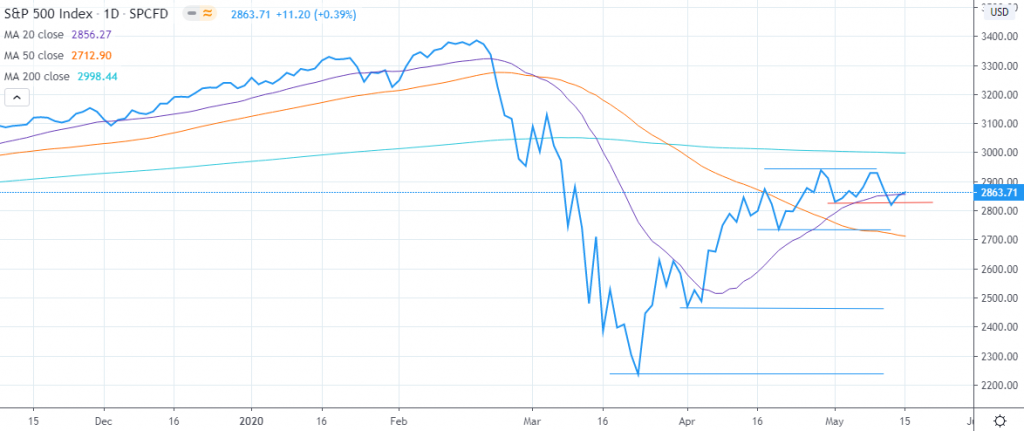Fauci and the Fed deliver rough news for global markets
Last week I talked about the market 'testing resistance', given the focus on whether the S&P 500 could break through recent highs of 2,930 and march onward to 3,000. As it turned out, the market did test, but failed to break, this resistance, given the double blows from both U.S. virus guru Dr. Fauci and Fed chair Powell. With growing speculation of a move to negative interest rates by some central banks, gold prices also pushed higher, even as the $US firmed.
Fauci doused re-opening euphoria by reminding the U.S. public that the virus was not yet under control across the country, and opening up too quickly could hurt more than help the economy. Powell, meanwhile, pleaded for more fiscal stimulus, noting the U.S. recovery was still subject to "significant downside risks".
Simmering U.S.- China tensions added to the market unease. A higher than expected 2.9 million filed for jobless claims last week, taking the total over recent weeks to 36 million. Various 'nowcast' estimates suggest the annualised decline in Q2 U.S. GDP is likely to be anywhere from 30% to 50%.
So this week, we have the S&P 500 testing support at recent lows around 2,820 - a break of which would see next support at the April 21 low of 2,736.

Source: TradingView.com
Perhaps the key global event to watch this week is U.S.-China relations - and whether Trump will risk Wall Street's wrath by increasing tensions. Powell testifies before Congress on Tuesday, where he's likely to again try and strike a balance between longer-run optimism and shorter-run risks (thereby requiring more fiscal support).
He'll also likely douse speculation of a move to negative interest rates if and when asked. Thursday's weekly jobless claims are expected to ease further, but remain at an uncomfortably high 2.4 million. Also on Thursday, preliminary estimates of the Markit U.S. manufacturing and service sector May indices are released, which are likely to show a modest bounce, though still remain at very low recessionary levels.
In Europe, meanwhile, it's noteworthy that both Italy and the U.K. are opening up even while conceding this comes at the risk of a renewed spike in virus cases. As the economic costs of shutdown mount, this is a difficult trade-off that many countries are now facing. And while the decision to err on the side of re-opening is economically positive in the short-run, the inherent risks and uncertainties continue to argue against speedy "V-shaped" recoveries in both economic growth and share markets.
Australian Market
The local highlight last week was the stunning loss of almost 600,000 jobs in the April labour force report. Thanks to an equally stunning effective exit of 500,000 workers from the labour force - because they did not define themselves as actively looking for a job - the rise in the unemployment rate was limited to 6.2%. But an extra 600,000 workers now also counted themselves as 'underemployed', taking the total under-utilisation rate (unemployed plus underemployed) to a whopping 19.9%.
Along with the 6 million workers tenuously linked to their employers (so not technically unemployed) thanks to the JobKeeper program, it's probably fair to say a true estimate of Australia's unemployment rate today could be easily 30% - or twice that recently reported in the United States!
The RBA's Quarterly Statement was released on Friday, with the key (dispiriting) highlight being the Bank's concession that its base case view is that the unemployment rate could still be 8.5% in mid-2021.
There's little major data this week, with RBA minutes released on Tuesday and another public appearance by Governor Lowe on Thursday.

Source: ABS
In other news, consumer confidence did encouragingly bounce back somewhat in May, albeit remained at very low levels. More mixed was the National Australia Bank business survey for April, which revealed a lift in very low confidence levels but a further (unsurprising) slump in actual business conditions.
As regards financial markets, local equities remain stuck in a narrow range, held down by the still struggling financial sector. That said, solid Chinese steel production and concerns with regard to Brazilian supply (as CV-19 ravages the country) are supporting iron-ore prices and the local resources sector.
Never miss an insight
Each week I will publish my latest thoughts on the macro events shaping the ETF landscape. To be the first to read my insights, hit the follow button below.
4 topics

